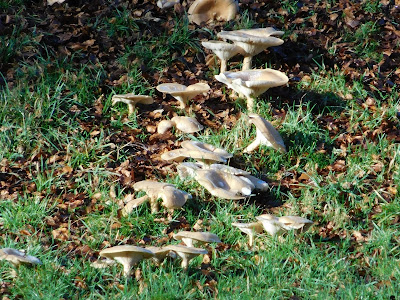As it's miserable weather today, I thought I would catch up on recording some of my grassland fungi findings of the last few weeks.
Dusky Puffball- Lycoperdon nigrescens
Peppery Roundhead-Stropharia pseudocyanea
The above are a selection of Earthtongues.
These are the 'G', in the CHEGD indicator species of unimproved grassland fungi.
Earthtongues are split into three categories;
Geoglossum, Trichoglossum, and Microglossum.
They are difficult to identify without the aid of a microscope.
The specimen in the bottom two images clearly has hairs,
so I'm presuming it's a Trichoglossum (Hairy Earthtongue) species.
I did find other hairless specimens, including the one in the second image.
Peachy Steve is going to dust off his microscope, so we can have a better chance of narrowing down an identification.
The above images are of the Blue Edge Pinkgill-Entoloma serrulatum.
This is one of the easier Entolomas to identify,
with its velvety, blue-black cap, and its serrated, blue edged gills.
Lilac Pinkgill-Entoloma porphyrophaeum
This is a large, robust species, that is tinged purple and often seen with a twisted stipe,
as the picture above shows.
Entolomas form the 'E' group in CHEGD indicator species.
Scarlet Caterpillarclub-Cordyceps militaris
This club fungus grows from the buried larvae of butterflies and moths
Crazed Cap-Dermaloma cuneifolium
Dermalomas are the 'D' in the CHEGD list of unimproved grassland indicator species.
Note the pale edge to the cap, and the way the cap cuticle overhangs the edge of the gills.
The following images are of Waxcaps.
These are the 'H' (Hygrocybe) in the CHEGD indicator species, and come in a stunning range of colours.
The above image shows the variety of colours that the Parrot Waxcap- Gliophorus psittacinus can be found in.
Scarlet Waxcap-Hygrocybe coccinea
Goblet Waxcap-Hygrocybe cantharellus
Note the scales to the cap, and the deeply decurrent gills.
Splendid Waxcap-Hygrocybe splendidissima
This waxcap has pink/orange gills with a paler edge.
Vermillion Waxcap-Hygrocybe miniata
Top image pictures the fungus next to a small hand lens, so gives an idea of its small size.
Note the scurfy texture of the cap.
Meadow Waxcap-Cuphophyllus pratensis
This fungus is firm fleshed, has a cap ranging from deep orange, to apricot, and fading to buff.
Stipe can be white, or apricot tinged. Its gills are decurrent.
I think this specimen may be the Persistent Waxcap- Hygrocybe acutoconica.
Went back to get a second opinion from Peachy Steve, but it was no longer there!
Blackening Waxcap-Hygrocybe conica
Glassy Waxcap-Gloioxanthomyces vitellinus
This fungus has a relatively long stipe compared to its small cap.
This specimen had a cap measuring 1.5cms.
It is fairly short lived in my experience.
Orange Waxcap-Hygrocybe aurantiosplendens
Note the sticky cap that is darker orange to the centre, the pale yellow gills, and the powdery apex to the stipe.
The above two images are of the Glutinous Waxcap- Hygrocybe glutinipes.
This fungus is extremely slimy/sticky.
If you zoom in on the stipe on the top image, you can see the globules of slime.
Pink Waxcap-Porpolomopsis calyptriformis
Clearly showing why it is also called 'The Ballerina', with its upturned 'tutu'
Slimy Waxcap-Gliophorus irrigatus
Honey Waxcap-Hygrocybe reidii
The 'C' fungi that complete the CHEGD indicator species are the clubs.
I have included the ones I have found over the last few weeks, but apologies for the poor photos!
? both Apricot Club-Clavulinopsis luteoalba.
I'm not very good at these! Peachy Steve?
Smoky Spindles-Clavaria fumosa
White Spindles-Clavaria fragilis
Meadow Coral-Clavulinopsis corniculata
































































